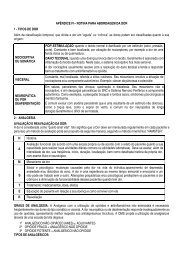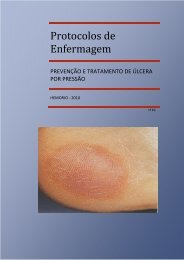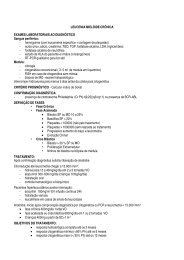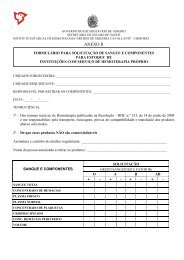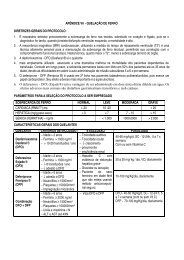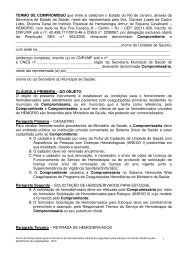Protocols - Hemorio
Protocols - Hemorio
Protocols - Hemorio
You also want an ePaper? Increase the reach of your titles
YUMPU automatically turns print PDFs into web optimized ePapers that Google loves.
ANALGESIA DEGREES: Analgesia, with the usage of opioid and non steroidal anti-inflammatory, is<br />
frequently necessary for pains of the somatic and visceral type. The neuropathic or deafferentation pain<br />
responds improperly to the usage of opioid, presenting a better response to the tricyclic antidepressant.<br />
The WHO proposes the usage of analgesic through a ladder of three steps:<br />
1 st NON- OPIOIC ANALGESIC (ANES) + ADJUVANTS<br />
2 nd WEAK OPIOID + NON-OPIOID ANALGESIC<br />
3 rd STRONG OPIOID + NON-OPIOID ANALGESIC<br />
TYPES OF ANALGESIC:<br />
NON OPIOID Dipirona / Acetaminophen / AAS / Paracetamol<br />
NON STEROIDAL<br />
ANTI-<br />
INFLAMMATORY<br />
AAS / Diclofenac / Indomethacin / Ibuprofen<br />
WEAK OPIOID Codeine / Tramadol Hydrochloride / Propoxyphene<br />
STRONG OPIOID Morphine / Fentanyl / Pethidine / Buprenorphine / Nalbufine / Methadone /<br />
Oxycodone / Sufentanil / Alfentanil / Remifentanil<br />
ADJUVANTS Anticonvulsant / Antidepressant / Neuroleptic / Benzodiazepine / Anticholinergic<br />
3 - ANALGESIC, ANTI-INFLAMMATORY AND ANTIPYRETIC:<br />
Consider that the anti-inflammatory dosage is already the maximum analgesic dosage. Therefore, the<br />
increase of the dose of such drugs or the association of another drug of the same group would only result<br />
on an increment of the adverse effects, not providing any satisfactory analgesia. Consequently, if there is<br />
no satisfactory analgesia, we must pass to the second degree of the analgesic ladder. In this group, only<br />
paracetamol, at the usual doses, is not an anti-inflammatory.<br />
INDICATIONS:<br />
In every type of acute pain and in every type of pain that presents an inflammatory component with<br />
release of inflammatory substances (all acute pains and some chronic pains).<br />
At the primarily inflammatory nature pains, with a mild to moderate intensity as the first agent, it must be<br />
used parenterally at the intense pain.<br />
At the mild to moderate pains, use non steroidal anti-inflammatory (AINES) with a short half-life: aspirin,<br />
ketoprofen and paracetamol.<br />
At the osteo-articular, subacute pains, which may last for a period of about 10 days, we may prescribe<br />
derivatives with a long action; however they just reach a stable plasmatic concentration in approximately 4<br />
days.<br />
HOW TO PRESCRIBE:<br />
Always use a regular regimen, observing the half-life of the drugs.<br />
Associate the opiace whenever it has reached the maximum dosage, without obtaining a satisfactory<br />
analgesia.<br />
Use preferably the oral path, the parenteral path is indicated when you want to reach plasma<br />
concentrations fastly (e.g., post-operatory) and when the subject is incapable to deglute.<br />
199



